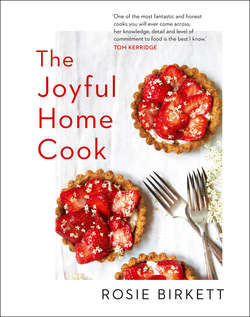Читать книгу The Joyful Home Cook - Rosie Birkett - Страница 15
ОглавлениеSimple sourdough
Proper sourdough bread is a truly magnificent thing. It’s bread made the old-fashioned way, slowly and reverently, without the use of any industrially produced yeast, but rather leavened or raised with a starter culture made from naturally occurring yeasts and bacteria that awaken when flour and water are mixed together. The resulting fermentation yields something altogether more flavourful and satisfying than mass-produced bread, and in recent years we’ve seen a sourdough revolution, a movement of artisan bakers the world over who are re-embracing the craft of making slow-fermented doughs and beautiful, delicious and nutritious loaves. A really good loaf of sourdough takes time to make, but it becomes the basis for so many good, quick meals that it more than pays you back for the time you’ve invested.
Now, while I do think that squishy white bread still has a place – I can’t imagine a bacon sandwich made with sourdough or, worse still, a chip butty – after interviewing bakers and chefs and tasting this delicious style of bread at many restaurants over the years, I became fascinated by the process, and obsessed with mastering the art of making sourdough at home. The idea that it was possible to raise an army of hard-working yeast who would obligingly leaven loaves of bread, producing gut-friendly acids that make that bread easier on the digestion, more nutritious and tasty in the process, had me hooked.
There are books and courses dedicated to sourdough, and if you want to delve deeper I’d recommend these books for further reading – Do Sourdough by Andrew Whitley, The Handmade Loaf by Dan Lepard, and Flour, Water, Salt, Yeast by Ken Forkish – but please don’t be intimidated. For centuries people have been making bread this way, simply using flour and water, without technical equipment, and once you begin to wrap your head around the process, anyone can bake loaves at home, and really enjoy the journey of discovering what works for you.
The gist of it is that you create a leaven by mixing together good-quality flour and water. The yeasts and bacteria already present in the flour thrive and multiply in this wet environment, feasting on the sugars in the flour and creating carbon dioxide (the bubbles that will eventually raise your bread), and lactic acid, which give the bread its signature sour flavour. You have to feed the starter initially to help the network of yeasts and lactobacilli become strong, and once this starter is a happy and lively culture, you introduce it to more flour and water and allow it to continue its work, creating a fermented and flavourful dough that is then baked into delicious bread.
This is a simple, entry level recipe and it’s relatively hands off. The trick is to let the bread work around your schedule, rather than keeping you prisoner. This method consistently delivers loaves of good bread that I base many meals around, and I hope you will too. You will need a few things to get started, but none of them are outrageously expensive or unattainable: an ovenproof ceramic or cast-iron pot to bake your bread in, good-quality organic wholegrain rye flour, some digital scales and a sharp knife or razor blade for slashing the dough before baking. I use a casserole pot I found in a charity shop to bake mine, but you could use a small Le Creuset, a Pyrex dish with a lid or a stewing pot. Please use this as a jumping off point for your sourdough experiments. I’m convinced, when you see what a natural, simple and satisfying process it is, you too will be hooked.
